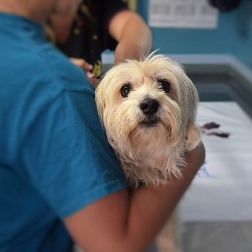How to Choose a Vet Tech Program near Belt Montana
 Fulfilling your long term dream of working with and helping animals by enrolling in a veterinary technician program near Belt MT could at first feel like a daunting undertaking. After all, you must search for and enroll in a college that will provide the proper training to ensure that you can succeed as a vet tech. But just how do you go about evaluating and comparing programs so that you can make the right selection? Many aspiring students begin their due diligence process by searching for schools that are near their homes. After they have located some area schools, they determine which ones have the lowest tuition and focus on those. Although expense and location are significant considerations when evaluating vet technician schools, they are not the only important ones when making your assessments. Factors such as internship programs and accreditation need to be looked into also. The main idea is that there are questions you ought to be asking the veterinary technician schools you are evaluating before you make a final decision. We have furnished several in this article to help get you started, but before we review them we’ll explore the varied responsibilities of vet techs and the training alternatives offered.
Fulfilling your long term dream of working with and helping animals by enrolling in a veterinary technician program near Belt MT could at first feel like a daunting undertaking. After all, you must search for and enroll in a college that will provide the proper training to ensure that you can succeed as a vet tech. But just how do you go about evaluating and comparing programs so that you can make the right selection? Many aspiring students begin their due diligence process by searching for schools that are near their homes. After they have located some area schools, they determine which ones have the lowest tuition and focus on those. Although expense and location are significant considerations when evaluating vet technician schools, they are not the only important ones when making your assessments. Factors such as internship programs and accreditation need to be looked into also. The main idea is that there are questions you ought to be asking the veterinary technician schools you are evaluating before you make a final decision. We have furnished several in this article to help get you started, but before we review them we’ll explore the varied responsibilities of vet techs and the training alternatives offered.
The Job of a Vet Tech in Belt MT
 One of the first decisions that you will have to make is if you wish to train as a veterinary technician, assistant or technologist. Part of your determination might be dependent on the amount of time and money that you have to commit to your education, but the primary factor will undoubtedly be which specialization interests you the most. What techs and assistants have in common is that they both work under the direct supervision of a practicing and licensed veterinarian. And even though there are many tasks that they can perform within the Belt MT veterinary clinic or hospital, they can’t prescribe medicines, diagnose ailments, or conduct surgeries. In those areas they can only provide assistance to a licensed veterinarian. There are technicians and technologists that work away from the standard vet practice, for example for animal shelters, zoos or police departments. Let’s take a look at the responsibilities and education requirements for each specialization.
One of the first decisions that you will have to make is if you wish to train as a veterinary technician, assistant or technologist. Part of your determination might be dependent on the amount of time and money that you have to commit to your education, but the primary factor will undoubtedly be which specialization interests you the most. What techs and assistants have in common is that they both work under the direct supervision of a practicing and licensed veterinarian. And even though there are many tasks that they can perform within the Belt MT veterinary clinic or hospital, they can’t prescribe medicines, diagnose ailments, or conduct surgeries. In those areas they can only provide assistance to a licensed veterinarian. There are technicians and technologists that work away from the standard vet practice, for example for animal shelters, zoos or police departments. Let’s take a look at the responsibilities and education requirements for each specialization.
- Vet Assistants in almost all cases will have undergone a structured training program, either as an intern or apprentice in a vet clinic or hospital, or by completing a certificate program at a trade school or community college. As the name implies, their job function is to assist the vets and vet techs in the execution of their duties. Usually they are not associated with more involved undertakings, such as assisting with surgeries. A few of their regular responsibilities may include working at the front desk, preparing and cleaning exam rooms and equipment, or controlling animals during exams.
- Vet Technicians go through more extensive training compared with assistants and usually obtain a two year Associate Degree, preferably from an American Veterinary Medical Association (AVMA) accredited program. They are in a fashion the vet equivalent of medical nurses, since their basic job duty is to assist vets with diagnosing and treating animal patients. Where they differ from veterinary assistants is that they are engaged in more complex tasks, such as assisting with surgeries or providing medicine. All states currently mandate that veterinary techs pass a credentialing examination for either certification, registration or licensing.
- Vet Technologists are comparable to vet technicians and essentially perform the same job functions. They are mandated to attain a Bachelor’s Degree in veterinary technology, which normally requires 4 years. So the main distinction between a vet technician and a technologist is the technologist’s more advanced level of education. But with an advanced degree comes more career options, increased salaries and potential management positions. They are additionally mandated to pass a credentialing exam for either certification, registration or licensing.
Veterinary techs and technologists may specialize in areas such as anesthesia, internal medicine or urgent care. Many may acquire certification from the American Association for Laboratory Animal Science (AALAS) to work in Belt MT laboratories or research facilities also.
Vet Tech Online Schools Offered in Belt
 An approach that may be a solution for those with a busy schedule or who are working full time while going to vet college is to enroll in an online program. Because the classes are made available via the internet, students can study on their own schedule wherever a computer is accessible. The curriculum is taught using various methods, including videos, slide shows and live streaming webinars. And since many veterinary technician and technologist degrees require practical training, that segment can typically be carried out as an internship or work study program at a local Belt MT veterinarian clinic or hospital. Distance learning, as it is also called, can in some instances decrease the cost of your education. Tuition and supplementary costs, for instance for traveling and study supplies, can be cheaper compared to more standard classroom programs. Just make certain that the online school that you select is accredited, either by the AVMA or another nationally certified accrediting organization. With the online classes and the practical training, everything is included for a complete education. So if you are disciplined enough to learn in this more independent mode, an online veterinary technician school may be the right choice for you.
An approach that may be a solution for those with a busy schedule or who are working full time while going to vet college is to enroll in an online program. Because the classes are made available via the internet, students can study on their own schedule wherever a computer is accessible. The curriculum is taught using various methods, including videos, slide shows and live streaming webinars. And since many veterinary technician and technologist degrees require practical training, that segment can typically be carried out as an internship or work study program at a local Belt MT veterinarian clinic or hospital. Distance learning, as it is also called, can in some instances decrease the cost of your education. Tuition and supplementary costs, for instance for traveling and study supplies, can be cheaper compared to more standard classroom programs. Just make certain that the online school that you select is accredited, either by the AVMA or another nationally certified accrediting organization. With the online classes and the practical training, everything is included for a complete education. So if you are disciplined enough to learn in this more independent mode, an online veterinary technician school may be the right choice for you.
Questions to Ask Belt MT Vet Tech Programs
 At this point you should have selected which veterinary credential that you wish to earn, and if you want to study online or attend a college on campus. Since there are an abundance of vet community colleges, vocational and trade schools in the Belt MT area as well as across the United States, you need to ask some qualifying questions to help fine tune your list of alternatives. As we mentioned in our opening, many future students start by concentrating on location and tuition expense. But we have already mentioned other significant qualifiers, such as internship programs and accreditation. And of course you need to enroll in a college that offers the specialty and degree that you want to earn. These and other qualifications are addressed in the checklist of questions that you should ask the veterinary technician schools that you are reviewing.
At this point you should have selected which veterinary credential that you wish to earn, and if you want to study online or attend a college on campus. Since there are an abundance of vet community colleges, vocational and trade schools in the Belt MT area as well as across the United States, you need to ask some qualifying questions to help fine tune your list of alternatives. As we mentioned in our opening, many future students start by concentrating on location and tuition expense. But we have already mentioned other significant qualifiers, such as internship programs and accreditation. And of course you need to enroll in a college that offers the specialty and degree that you want to earn. These and other qualifications are addressed in the checklist of questions that you should ask the veterinary technician schools that you are reviewing.
Is the Veterinary School Accredited? It’s imperative that you verify that the veterinary technician college you choose is accredited by a regional or national accrediting agency. As earlier discussed, one of the most highly regarded is the American Veterinary Medical Association (AVMA). Vocational schools and colleges that are accredited by the AVMA have undergone a rigorous screening process that verifies you will obtain a superior education. Also, accreditation is important if you are applying for a student loan or financial assistance, since many programs are not available for non-accredited programs. Last, having a certificate or degree from an accredited college is frequently a precondition for employment for many Belt MT area veterinary clinics and hospitals.
What is the Program’s Reputation? The vet college or trade school and program you choose should have an excellent reputation within the vet field. You can initiate your due diligence by asking the colleges you are looking at for references from the employers in their job placement network. Other suggestions include checking with internet school rating websites and checking with the school’s accrediting agencies as well. You can ask the Montana school licensing authority if there have been any complaints or violations involving your targeted schools. As a final pointer, call some Belt MT vet clinics that you might wish to work for after you go through your training. Ask what they think about your school selections. They may even suggest one or more schools not on your list.
Are Internships Offered? The best means to obtain clinical hands on training as a vet tech is to work in a professional environment. Find out if the programs you are looking at have internship programs set up with Belt MT veterinarians, vet hospitals or clinics. Almost all veterinary medicine programs require practical training and many furnish it by means of internships. Not only will the experience be invaluable regarding the practical training, but an internship can also help build connections in the local veterinarian community and aid in the search for a job after graduation.
Is Job Assistance Provided? Searching for a job after graduating from a vet tech program may be challenging without the assistance of a job placement program. To begin with, find out what the graduation rates are for the programs you are evaluating. A low rate may signify that the instructors were ineffective at teaching the curriculum or that a number of students were unhappy with the program and quit. Next, confirm that the colleges have a job placement program and find out what their placement rates are. A high placement rate might signify that the program has an outstanding reputation within the Belt MT vet community and has a substantial network of contacts for student placements. A lower rate may mean that the training is not well regarded by employers or that the job placement program is ineffective at placing students.
How Large are the Classes? If the classes are larger, you may get little or no individualized instruction from the teachers. Solicit from the Belt MT colleges you are looking at what their classroom student to teacher ratios are. You might also decide to sit in on a couple of classes (if practical) to observe the interaction between teachers and students. Get feedback from students regarding the quality of instruction. Also, talk with the instructors and find out what their backgrounds are as well as their methods of teaching.
Where is the College Located? Of course, we previously discussed location, but there are a couple of more points to consider on the topic. If you are planning to drive to your vet tech classes from your Belt MT home, you must make certain that the driving time fits into your schedule. For example, driving during the weekend to check out the route won’t be the same as the commute during rush hour traffic, particularly if the college is located in or close by a large city. Also, if you do choose to enroll in a college in another state or even outside of your County of residence, there may be higher tuition costs especially for state and community colleges. On the other hand, taking classes online may be an alternative that will give you more flexibility and minimize the necessity for travel.
Is the Class Schedule Flexible? And last, it’s imperative that you determine if the veterinarian programs you are looking at offer class times flexible enough to fit your schedule. For example, a number of students continue to work full time and can only attend classes on the weekends or in the evenings near Belt MT. Some might only be able to go to classes in the morning or in the afternoon. Make certain that the class times you need are offered prior to enrolling. In addition, find out if you can make-up classes that you may miss due to work, illness or family emergencies. You may find that an online program is the ideal solution to fit your vet education into your hectic life.
Enrolling in a Vet Tech School near Belt MT?
If you have decided to attend a Veterinary Technician Program in the Belt Montana area, then you may find the following information about the location of your school campus interesting and informing.
Belt, Montana
Belt is located at 47°23′9″N 110°55′36″W / 47.38583°N 110.92667°W / 47.38583; -110.92667 (47.385935, -110.926587).[7] According to the United States Census Bureau, the town has a total area of 0.35 square miles (0.91 km2), all of it land.[1]
As of the census[2] of 2010, there were 597 people, 261 households, and 159 families residing in the town. The population density was 1,705.7 inhabitants per square mile (658.6/km2). There were 295 housing units at an average density of 842.9 per square mile (325.4/km2). The racial makeup of the town was 95.5% White, 1.7% Native American, 0.5% Asian, 0.2% from other races, and 2.2% from two or more races. Hispanic or Latino of any race were 1.0% of the population.
There were 261 households of which 29.1% had children under the age of 18 living with them, 47.5% were married couples living together, 10.7% had a female householder with no husband present, 2.7% had a male householder with no wife present, and 39.1% were non-families. 33.0% of all households were made up of individuals and 13.7% had someone living alone who was 65 years of age or older. The average household size was 2.29 and the average family size was 2.92.
Choose the Right Vet Tech College near Belt MT
 Enrolling in the appropriate vet tech college is a critical first step to beginning a fulfilling career delivering care and treatment for pets and livestock. Future students looking into veterinary technician schools must make their determination based on several key issues. Veterinary technicians and technologists are employed in animal hospitals, veterinary clinics and animal shelters. They commonly take on administrative responsibilities and support the veterinarian with the animals when needed. As we have discussed, it’s imperative that you decide on a veterinary medicine program that is both accredited and has an excellent reputation within the field. This goes for vet tech online schools as well. By asking the questions provided in our checklist for reviewing schools, you will be able to narrow down your choices so that you can make your final selection. And by picking the best program, you can reach your goal of becoming a veterinary technician in Belt MT.
Enrolling in the appropriate vet tech college is a critical first step to beginning a fulfilling career delivering care and treatment for pets and livestock. Future students looking into veterinary technician schools must make their determination based on several key issues. Veterinary technicians and technologists are employed in animal hospitals, veterinary clinics and animal shelters. They commonly take on administrative responsibilities and support the veterinarian with the animals when needed. As we have discussed, it’s imperative that you decide on a veterinary medicine program that is both accredited and has an excellent reputation within the field. This goes for vet tech online schools as well. By asking the questions provided in our checklist for reviewing schools, you will be able to narrow down your choices so that you can make your final selection. And by picking the best program, you can reach your goal of becoming a veterinary technician in Belt MT.
Other Doggone Good Cities in Montana
Business Results 1 - 10 of 5






